#11 Quincy Pondexter, 6’7, Small Forward, Junior, Washington
After a very strong first few weeks in his freshman campaign, Quincy Pondexter’s game fell off considerably, and a season and a half later, it still hasn’t returned. Pondexter didn’t do anything to rebound from a disappointing close to his freshman season, as his numbers fell off even more as a sophomore, with his production remaining about the same while his efficiency dropped considerably, from 50% to 45% FG%, 76% to 69% FT%, and 38% to 29% 3PT%. On the bright side, Pondexter did have a few nice blips on the radar to close the season, with a 23-point game against California and a 19-point game vs. Stanford making up somewhat for a fairly underwhelming sophomore campaign. A 6-7 small forward with all the physical tools you look for in an NBA prospect at that position, Pondexter will be given many more chances to show his value to decision makers thanks to his considerable upside.
On the offensive end, Pondexter is at his best attacking the basket, despite not having the greatest ball-handling abilities. He’s not great with the ball in space and doesn’t possess many advanced moves in his arsenal, but at the same time, he’s way more than a straight-line driver. Pondexter likes to operate starting with the ball in the 15-18 foot range, attacking from the pinch, wing, or baseline. He does most of his damage on two or three-dribble drives, making truly exceptional use of crafty maneuvers like jump stops, pivots, up fakes, spin moves, and subtle changes of direction. He’s especially good with the jump stops, utilizing them to both change direction and gather himself to make full use of his very good explosiveness. In this area of his game, he has a very high comfort level, and shows good instincts in making difficult maneuvers, using his good footwork as well. Honing his ability to create his own shot and becoming a better decision maker with the ball would serve him well moving forward considering his excellent natural tools.
At the basket, Pondexter is good at powering up over opponents to score, and has a nice right-handed floater as well, but his touch on lay-ups around the basket is average at best. This shows up in his post game as well, where he shows noticeably less comfort and instincts than he does in his slashing game. While capable of punishing smaller opponents, Pondexter doesn’t make great reads with his back to the basket, often winding up forcing a tough shot.
Pondexter also has a respectable jump shot in his arsenal, definitely being at his best with a set shot in space. He has fairly good form, with a high release that has moderate speed, though he suffers some inconsistencies, be it not getting his legs under him, not holding his follow through, or having his arm drift slightly to the right. He also doesn’t seem to have a great feel for shooting the ball, with quite a few bad misses coming from the ball being noticeably overpowered or underpowered. Pondexter isn’t really a threat to create and pull-up off the dribble, and his accuracy falls off when he’s strongly contested. He’ll definitely want to continue working on his set shot, which will be important for his future at the next level.
Defensively, Pondexter has made progress, but still has some work to do. His physical abilities are very good on this end of the court as well, and he’s finally making some strides to applying them better. He does a good job staying in a pretty consistent stance and plays with a high effort level as well. The results are inconsistent, though, as at times he’ll play very well, showing very good lateral quickness, sticking with his man step-for-step, and using his length to really bother the opposition. At other times, though, he’ll give too much space to shooters or get sold badly on jab steps or change-of-direction moves. He also is prone to getting into foul trouble, which keeps his minutes per game down to a low 24.4 per game.
While his numbers fell off a bit due to inconsistency and other issues, Pondexter is still quite a skilled player with excellent physical abilities. If he could cut down on some of his foul trouble issues, improve his overall feel for the game, and do a better job of more consistently getting involved on the offensive end, he could definitely be in line for a breakout junior season, which his draft stock is in need of. It’s hard to project his NBA potential, as there are a lot of factors that will determine that in regards to his continued development, but his potential is still very high, and the first round is certainly not out of the picture if he can elevate his game over the next season or two.
#12 Jon Brockman, 6-7, Senior, Power Forward, Washington
Jonathan Givony
You’d be hard pressed to find many more productive big man in college basketball. The top returning rebounder in the NCAA (14.2 per-40 minutes pace adjusted) and 17th best returning scorer (21.8 per-40P.A.), Brockman quietly put up huge numbers all season long, to little fan fare. The fact that his team finished just 8th in the loaded Pac-10 (16-16 overall) did not help his cause obviously, so it will be imperative for Washington to make the NCAA tournament this season to give Brockman the type of exposure he needs in his senior campaign to help his NBA chances.
Severely undersized at 6-7, and not freakishly athletic to compensate for his physical shortcomings, Brockman is the type of player that finds a way to make his presence felt without any outstanding natural tools. His energy level is extremely high in every moment he’s on the court, playing a physical, scrappy style of basketball that renders him extremely effective at the collegiate level. Showing superb timing, hands and instincts crashing the glass, Brockman never gives up on a play and seems to relish throwing his body around and outworking opposing players inside the paint. This is largely the reason he was able to average over 14 rebounds per game per-40 minutes pace adjusted last season, and 12.6 the year before as a sophomore playing alongside eventual top-10 pick 7-footer Spencer Hawes.
Most of Brockman’s touches in UW’s offense come through the work he does with back to the basket at the center position. Strong and aggressive, but just not big or quick enough to always establish deep enough position inside, Brockman sees average results despite possessing nice touch and the ability to finish with either hand. He has a tendency to force the issue and heave up tough shots from difficult angles, clearly not being the greatest passer you’ll find around. Posting up and trying to overpower players around the basket is obviously not going to work very well in the NBA, but considering his college team’s severe lack of offensive talent, it was one of their best options last season.
Operating off the ball is where Brockman looks much more comfortable. He runs the floor extremely hard, regularly beating opposing big man down the court. He’s also extremely intelligent finding creases in the defense and moving to the right spot to catch and quickly finish around the rim, showing terrific hands and plenty of craftiness using the rim to shield his defender on the reverse lay-up. Brockman finishes 64% of his shot-attempts around the basket, which is impressive considering his average size and leaping ability. He gets to the free throw line at a great clip, seven times per-40 minutes pace adjusted, but only converts a mediocre 52% of his attempts.
Very much related to his stroke from the free throw line, Brockman does not possess much range on his medium range jump-shot, which is something he’ll have to work extremely hard on if he’s to convince NBA personnel that he can compensate for his poor physical tools and translate his college production to a much higher level of play. His shooting mechanics sport a long and deliberate hitch that makes his release slow and fairly inconsistent. Even though he’ll never be looked at as much of an offensive option, having the ability to space the floor and punish defenses who double-team his big man will make it much more difficult for them to play off him. Think Udonis Haslem. Similarly, Brockman would be well suited to develop his ball-handling skills to the point that he would be comfortable beating slower-footed opposing defenders off the dribble from the high post.
Defensively, Brockman isn’t quite as useful as you might hope considering his other shortcomings. His lack of size renders him fairly ineffective going up against taller big men in the post who are able to easily shoot over the top of him, and his average lateral quickness on the perimeter causes him to struggle here too. Brockman is relied upon so heavily to stay on the floor for Washington that he often is forced not to risk getting in foul trouble, which brings down his intensity level a notch. Still, he’s going to have to show scouts much better technique and effort to convince them that he’s not going to be a liability on this end of the floor at the next level. Those things are obviously not question marks when it comes to his ability to clean the glass, as already mentioned.
All in all, Brockman certainly isn’t what you would consider a great NBA prospect due to his very obvious shortcomings. Still, he has some nice qualities that some teams may find appealing (particularly his rebounding ability), and there is no doubt that he’ll be a fixture throughout the pre-draft process competing in private workouts and settings like Portsmouth and Orlando, so he will surely get his chance to show teams what he can do. It’s not out of the question that he ends up on someone’s roster when it’s all said and done, but there is a distinct possibility that he may have to ply his trade in Europe, where he would probably be considered a very hot commodity.
#13 Dwight Lewis, 6’5, Junior, Shooting Guard, USC
Rodger Bohn
Coming off a successful sophomore season, Lewis enters the year with the opportunity to play a larger role this year for the Trojans, trying to help replace the production of shooting guard O.J. Mayo, alongside talented freshman Demar DeRozan. The unexpected transfer of point guard Angelo Johnson will leave the bulk of the playmaking duties for USC in the hands of Daniel Hackett, leaving plenty of scoring opportunities for Lewis on the wing. From what we could see last year, Lewis is unlikely to shy away from the added responsibilities, as he’s a confident player with solid all-around scoring instincts.
Lewis has average size for an NBA shooting guard candidate at 6’5, although he does have a nice frame and a decent wingspan. Not a freakish athlete, he does have solid quickness and the willingness to make plays. Knowing his limitations, he seems to do the best of maximizing the talents that he has.
The main selling point that Dwight brings to the table as a prospect is his ability to defend, even though he doesn’t have outstanding size. He does an excellent job of fighting through screens and containing penetration, often asked to guard the other team’s best wing player during the season. Lewis doesn’t force a ton of turnovers, but his man to man defense is amongst the best as far as wings in the Pac-10 are concerned.
Not what you could call a prolific scorer at this stage of his career, Lewis is regardless not a one-dimensional player, looking equally comfortable putting the ball on the floor as he is shooting jumpers. He does a decent job as a catch and shoot player, quite capable of knocking down the deep jumper despite his poor shooting mechanics. His shot is fairly slow to develop and he cocks the ball too far behind his head to get a consistent release point, but his size allows him to get his shot off against most wing prospects, often to mixed results.
The junior does a very nice job of getting his hands ready and finding himself in the right spots, making him quite available to playmakers looking to pass the ball. He has nice touch, but will almost certainly have to improve his mechanics if he’s to reach his potential as a shooter and improve his all-around appeal as a prospect. Right now he needs more time and space to get his shot off effectively than he will be afforded against high-level defenses, due to his slow release. As evidence, he hit 45% of his open spot-up jumpers last season according to Synergy Sports Technology’s quantified report, compared to just 19% of his contested looks.
Not just a shooter, Lewis has shown pretty decent skills slashing to the rim, although those opportunities were few and far between last season playing with ball dominant guards. His high basketball IQ enables him to make proper reads coming off of screens and allows him to free himself up when closely guarded. When going to the rim, he shows off a solid first step, nice body control and some crafty moves to elude defenders, as well as better ball handling skills then most college shooting guards at this stage in their development.
Still, there is obviously quite a bit of room for development here too. Most noticeable is the fact that he clearly favors driving left. His first step is obviously slower going towards his right and his ability to finish at the rim also goes down when he heads this way. Opposing teams will quickly pick up on this and work to force him out of his comfort zone, so it’s important that he improves his versatility with the ball.
The Louisiana native has also shown issues with shot selection in the past, seemingly forcing bad shots in instances where he hasn’t touched the ball for a while. His confidence level didn’t always match his offensive polish at times last year, particularly in some key moments of the NCAA tournament for example, even if it was admirable to see him doing his best to relieve the bottleneck congestion that often plagued USC’s stagnant half-court offense. Lewis tends to over penetrate at times, take contested shots from the perimeter, and really struggles to find the open man when cut off going towards the basket, as well.
As a junior, Lewis will need to take his play to another level if he hopes to firmly implant himself on the NBA radar, even if he’s obviously a four-year prospect. Teams love players with the ability to defend, but he will have to show that he can be a credible threat on the offensive end (particularly as a shooter) if he hopes to eventually play in the NBA. With the abundance of youth that the Trojans will have though, there will be a plethora of opportunity for him to enhance his production in 08-09.
Aron Baynes, 6’10”, Senior, Center, Washington State
Joey Whelan
While the Cougars backcourt will be hurting with the loss of both Derrick Low and Kyle Weaver, their frontcourt will once again be anchored by the big Australian native. Baynes returns as the team’s leading scorer and rebounder despite playing just 24 minutes per game last season. One of the more fundamental players in the Pac-10 this season, Baynes will almost assuredly see an increase in playing time (assuming he managed to stay out of foul trouble), and his offensive output should improve as well.
Baynes is a physical presence and an absolute beast at the college level. Standing a legit 6’10” and packing on 270 pounds, he is a handful on the block for most defenders. While his strength and toughness are certainly NBA caliber, the rest of his physical attributes are not. He is a little undersized for a traditional post up player and he has little athleticism to speak of. Baynes isn’t a threat in the transition game, often lumbering up the floor or trailing a break, and his leaping ability is poor. Unless he has a clear lane with space to work with, he isn’t likely to dunk the ball due to his lack of explosiveness.
When we look at Baynes offensively, we are dealing with a player who almost exclusively functions within eight feet of the basket. He is an extremely fundamental player but he lacks any real creativity with his post moves. His bread and butter is a drop step into a jump hook, which while very effective when he has it going, can just as easily be shut down by bigger, athletic defenders.
Baynes shows excellent touch around the basket, even with contact, connecting on 60% of his field goal attempts last season. It isn’t uncommon to see him take a bump seven or eight feet from the rim and still knock down his jump hook. He absolutely needs to add more to his low post repertoire though; while he has been able to get away with this move against smaller defenders (14 points against Tyler Hansbrough) he struggled mightily against true centers (combined 15 points in 3 games vs. the Lopez twins). Averaging just one assist to every five turnovers, Baynes obviously has a lot of work to do on his ability to read defenses and find the open man.
Certainly something coaches love to see from players like Baynes is how often they get to the line. The senior averaged nearly 7 free throw attempts per 40 minutes thanks to his tremendous aggressiveness around the rim. He does a great job of getting position on defenders and then driving through them. Baynes doesn’t always get bailed out by foul calls, though, and this results in some difficult looks at the basket due to his poor leaping ability.
Where Baynes absolutely must improve is in his ability to step away from the basket. As previously mentioned, he almost exclusively plays around the rim, so we haven’t gotten very many opportunities to see him shoot the basketball; but if his 66% free throw shooting percentage is any indication, he has both potential in this area and some work to do before he is a threat to score from the mid-range. Solely overpowering defenders will not be as easy at whatever level Baynes moves onto from here, so developing that jump-shot will be a key for him.
Defensively, Baynes makes his presence felt at the collegiate level. He holds his position very well, rarely getting backed down by opponents, forcing them to either shoot over him or take a tough angled shot. As one would expect of a player like Baynes who lacks great quickness, he struggles against more versatile big men who can step away from the basket and attack off the dribble. He does do a good job on the defensive glass though, able to keep opponents on his back. His aggressiveness limits him at times, though, as he proved to get into foul trouble a lot, picking up a foul just about every 8 minutes.
Baynes is likely a long shot for the NBA, as there are some very obvious question marks about how he’ll fare against the much more athletic and talented big men that the League is known for. He is a man amongst boys at the NCAA level-- a strong, physical player who lacks versatility in his offensive game and has limited potential defensively, and doesn’t sport the type of upside you’ll find in other collegiate big man prospects. Certainly an asset at the collegiate level, he will likely have a terrific senior season, being more than capable of averaging a double-double in the Pac-10. Baynes’ toughness and coveted ability to score with his back to the basket probably makes him a better fit for a team in high-level Europe or in his native Australia when his time with Washington State is done. Regardless, he will get invites to settings like Portsmouth and possibly the pre-draft camp to show that he is capable of reaching higher.
Kamyron Brown, 6-2, Sophomore, Point Guard, Oregon
Kyle Nelson
Oregon point guard Kamyron Brown is likely one of the more obscure prospects featured in these lists, and for good reason. The 20-year sophomore did very little to demand attention during his freshman season, averaging just 4.2 points (40.8 FG, 25.8% 3FG, 57.4% FT), 1.6 rebounds, 3.1 assists, and 2.3 turnovers in 18.1 minutes per game. However, now that Maarty Leunen, Bryce Taylor, and Malik Hairston have graduated and taken over half of Oregon’s offensive possessions with them, many are expecting Brown and 5’6 junior combo-guard Tajuan Porter to pick up the slack and turn a rebuilding season into a pleasant surprise.
Brown certainly looks like he could be the player to take on such a task. Standing at what looks to be 6’2 and possessing a good wingspan, albeit a slight frame, he has good size, assuming he works on adding strength and weight to his frame, for an NBA point guard. Athletically, however, he has some work to do as he is neither overly explosive nor possesses an above-average first step. His average athleticism will hurt him at the next level, though with an off-season of conditioning under his belt, he may step back on the court a different player.
In terms of his offensive skill-set, Brown is extremely raw, as evidenced by his paltry freshman stats. There were some games, however, particularly his 20-point outburst against St. Mary’s, where his offensive abilities were on full display. Perhaps the most consistent feature of Brown’s offense at the present moment is his perimeter jump-shot, which he can take from a standstill or off of the dribble. His form is not great, but definitely looks salvageable, with a fairly fluid motion and quick, albeit deliberate, release. The problem is that he falls away from the basket during his shooting motion. This explains why he hits the front of the rim so often as well as why he only shot 25.8% from beyond the arc last season.
The other way in which Brown gets his points is by slashing to the basket. The problem, however, is that Brown is too weak to assert his influence around the basket and lacks the ball-handling abilities to move quickly with the ball in his hands. If he were to get stronger and improve his handle, he could become a far more efficient slasher because of his size, length, and what looks like a nice touch around the basket. Outside of that, however, he has little to no offense, lacking a mid-range game in its entirety and even the aforementioned offense rarely emerges outside of isolated flashes.
Brown does, however, look and play like a pure point guard: the instinct is clearly there. Unfortunately, the numbers rightly question that claim, as Brown averages 6.9 assists per 40 minutes pace adjusted and 5.1 turnovers per game per 40 minutes pace adjusted, good for second best, or worse, in college basketball. Watching him play, it seems as though his main problem is over thinking, particularly evident in his constant hesitation on and off the ball. Brown does not look confident in his abilities as a basketball player, from passing up open shots to leaving his feet without finding a passing target, from throwing a lob pass into a double team to trying to thread the needle when an entire defense has collapsed on the lane. As witnessed by his assist average, he does show solid vision and flashes of potential to be a solid point guard, but the tape suggests that in his freshman year, he was very much a freshman.
Defensively, he suffers most from a lack of awareness, focus, and consistency and looked very much like a freshman. This year, he will be expected to close his man out on the perimeter, run above screens rather than behind them, and maintain solid defensive rotations. Brown actually looks like he could develop into a very solid defender down the road. His long arms and above average lateral quickness combined with his size could prove to be tremendous assets should he begin to realize his potential.
Potential is a good word to sum up Kamyron Brown. Even though he is a year older than most in his class, he is, after all, only a sophomore, after all. Next year, Brown is going to be expected to find consistency and comfort in his offensive game. He is going to be expected to shoot and pass the ball with confidence and have belief in his abilities. With over half of last year’s possessions moving on to various levels of professional basketball around the world, Brown is going to have plenty of chances to showcase his improvements. If not, Kamyron Brown will continue to remain an obscure prospect.
)




 Rispondi Citando
Rispondi Citando







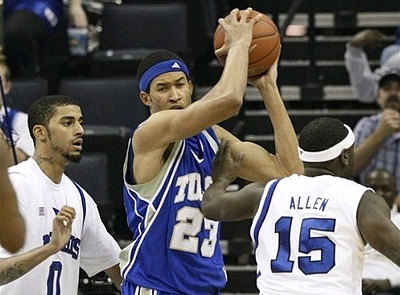 AP
AP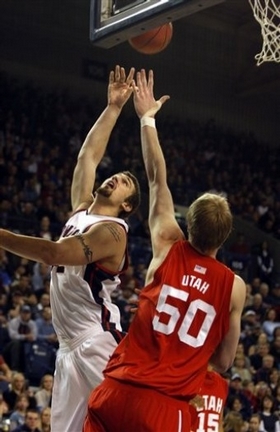 AP
AP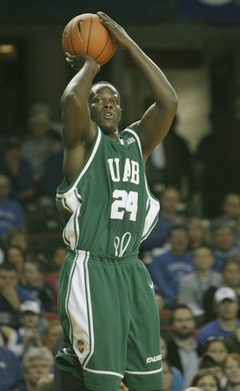 Icon SMI
Icon SMI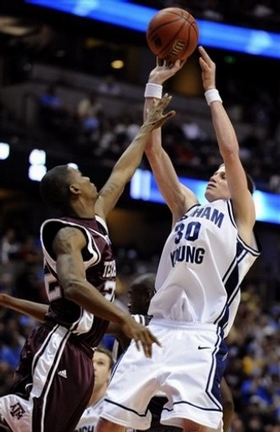 AP
AP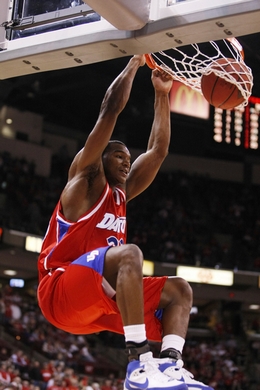 Icon SMI
Icon SMI
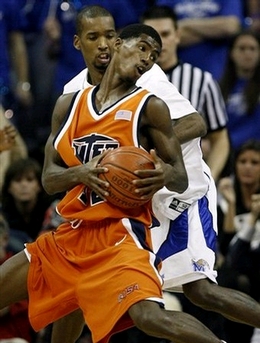 AP
AP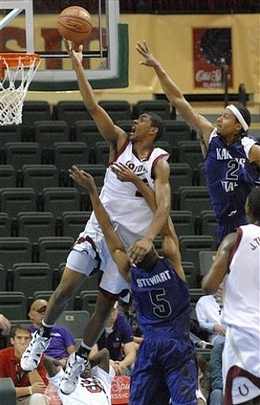 AP
AP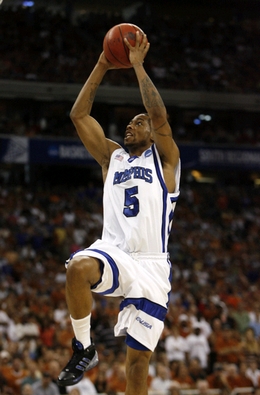 Icon SMI
Icon SMI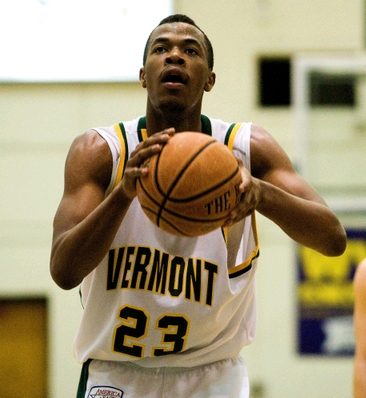 Icon SMI
Icon SMI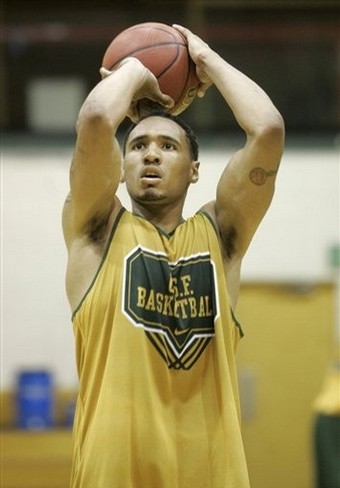 AP
AP
